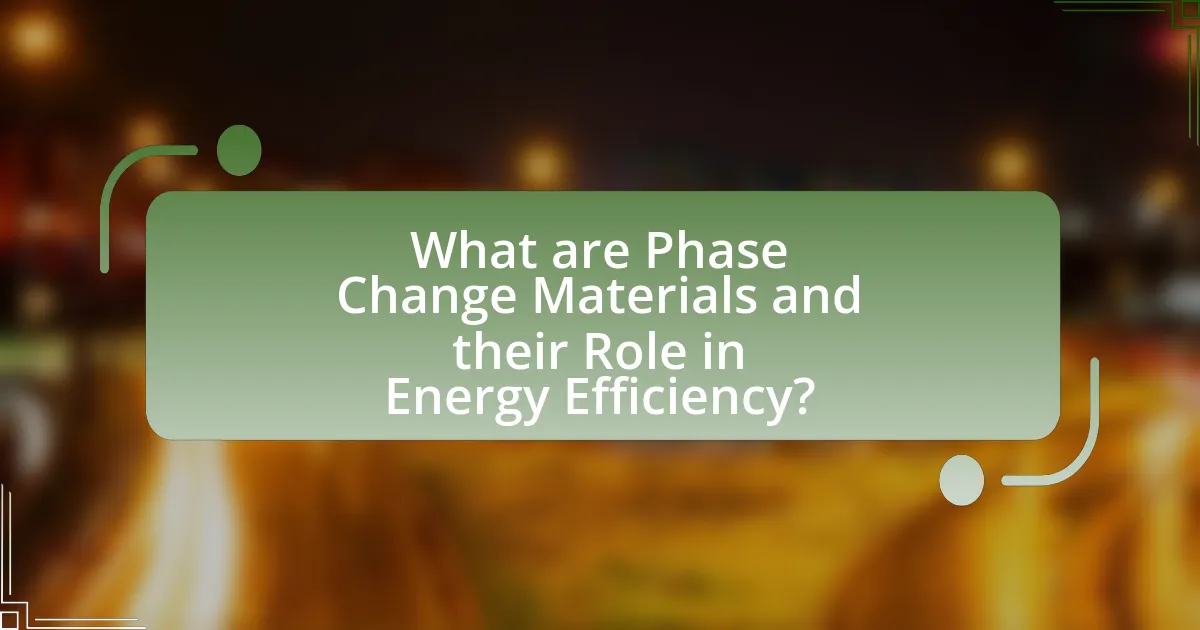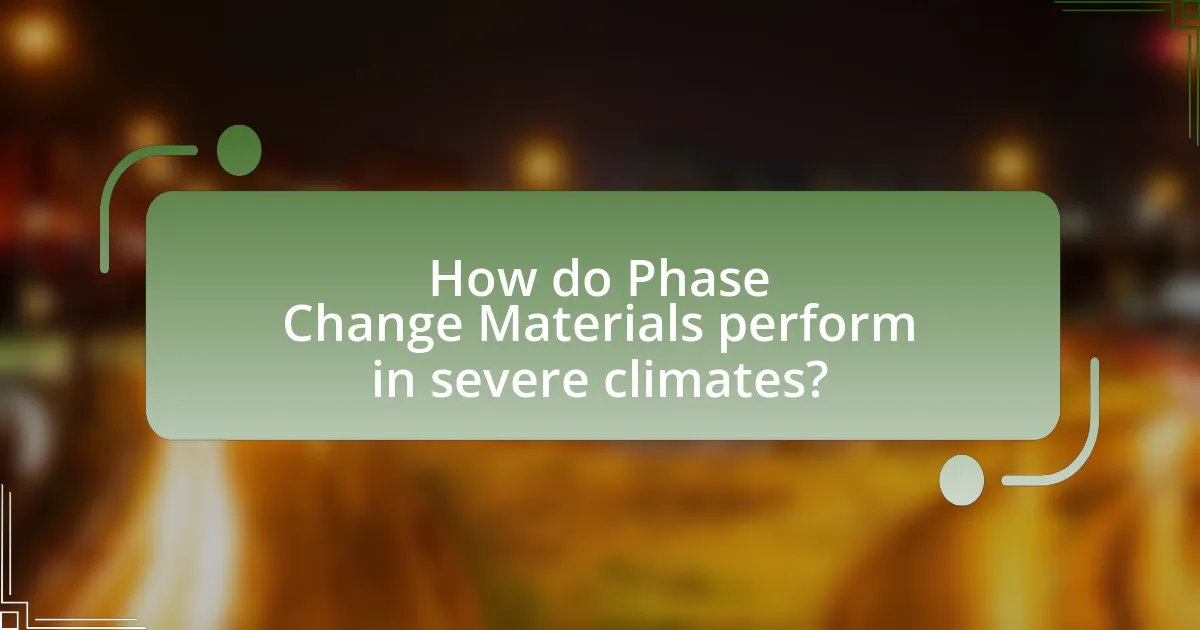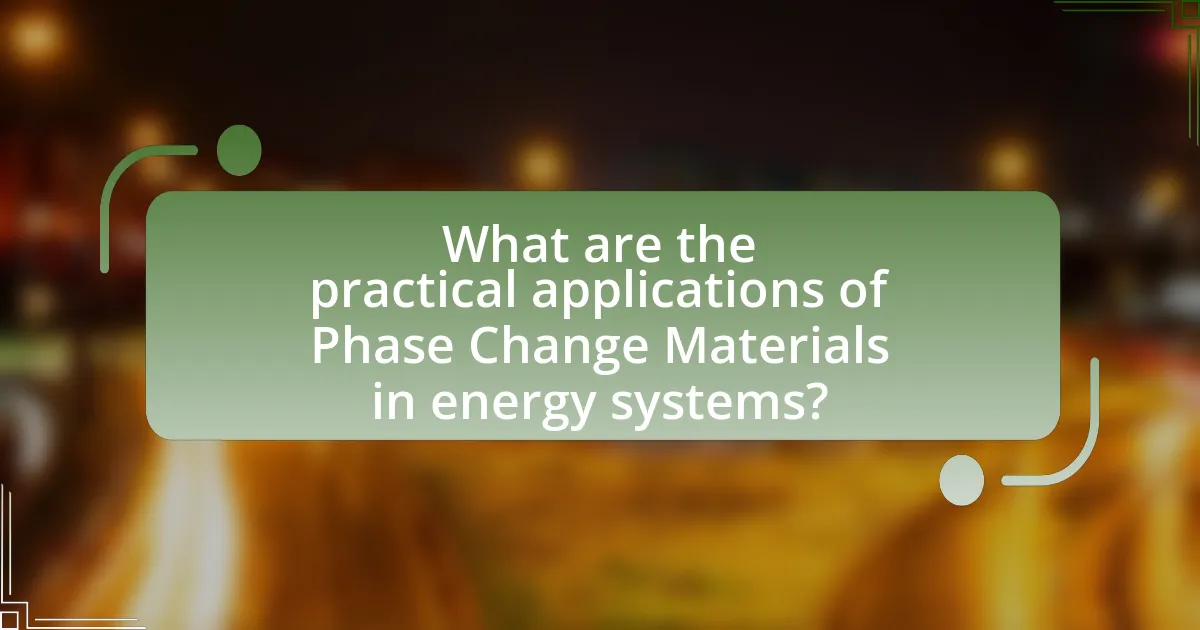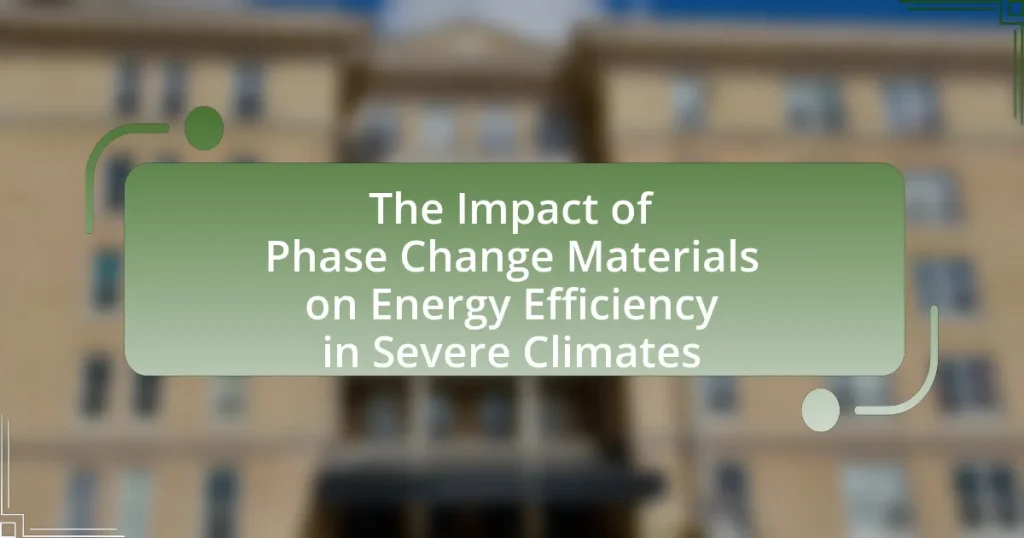Phase Change Materials (PCMs) are substances that regulate temperature by absorbing and releasing latent heat during phase transitions, significantly enhancing energy efficiency, particularly in severe climates. This article explores the functionality of PCMs in energy systems, highlighting their ability to reduce heating and cooling demands by up to 30%. It discusses the key properties of PCMs, their advantages over traditional insulation methods, and their practical applications in building designs. Additionally, the article examines the challenges posed by extreme weather conditions and how PCMs effectively address these issues, contributing to sustainable building practices and future innovations in energy efficiency.

What are Phase Change Materials and their Role in Energy Efficiency?
Phase Change Materials (PCMs) are substances that absorb or release latent heat as they change from solid to liquid or vice versa, thereby regulating temperature. Their role in energy efficiency is significant, as they can store excess thermal energy during peak temperatures and release it during cooler periods, reducing the need for heating and cooling systems. For instance, studies have shown that integrating PCMs in building materials can lead to energy savings of up to 30% in heating and cooling demands, particularly in severe climates where temperature fluctuations are extreme. This capability enhances overall energy efficiency by stabilizing indoor temperatures and minimizing energy consumption.
How do Phase Change Materials function in energy systems?
Phase Change Materials (PCMs) function in energy systems by absorbing, storing, and releasing thermal energy during phase transitions, typically from solid to liquid and vice versa. This process allows PCMs to regulate temperature fluctuations, enhancing energy efficiency in buildings and industrial applications. For instance, when temperatures rise, PCMs absorb excess heat, melting and storing energy, which can later be released as temperatures drop, solidifying and providing a stable thermal environment. Research indicates that integrating PCMs can reduce energy consumption for heating and cooling by up to 30%, demonstrating their effectiveness in improving energy efficiency, particularly in severe climates where temperature variations are significant.
What are the key properties of Phase Change Materials?
Phase Change Materials (PCMs) possess several key properties that make them effective for energy efficiency applications. These properties include high latent heat storage capacity, which allows them to absorb and release significant amounts of energy during phase transitions, typically between solid and liquid states. Additionally, PCMs exhibit a specific melting point, enabling them to maintain a stable temperature during energy absorption or release, which is crucial for temperature regulation in buildings. Furthermore, PCMs have good thermal conductivity, facilitating efficient heat transfer, and they are often non-toxic and environmentally friendly, making them suitable for sustainable energy solutions. These properties collectively enhance the performance of PCMs in improving energy efficiency, particularly in severe climates where temperature fluctuations are significant.
How do Phase Change Materials store and release energy?
Phase Change Materials (PCMs) store and release energy through the process of phase transitions, specifically by absorbing heat during melting and releasing heat during solidification. When a PCM is heated, it transitions from a solid to a liquid state, absorbing latent heat without a change in temperature, which allows it to store energy efficiently. Conversely, when the temperature drops, the PCM solidifies, releasing the stored energy back into the environment. This property enables PCMs to regulate temperature fluctuations, enhancing energy efficiency in buildings, particularly in severe climates where temperature variations are significant. Studies have shown that incorporating PCMs in building materials can reduce energy consumption by up to 30% by optimizing thermal performance.
Why are Phase Change Materials important for energy efficiency?
Phase Change Materials (PCMs) are important for energy efficiency because they store and release thermal energy during phase transitions, which helps regulate temperature in buildings and systems. By absorbing excess heat when temperatures rise and releasing it when temperatures drop, PCMs reduce the need for active heating and cooling, leading to lower energy consumption. Studies have shown that integrating PCMs into building materials can decrease energy use by up to 30% in extreme climates, demonstrating their effectiveness in enhancing energy efficiency.
What advantages do Phase Change Materials provide in severe climates?
Phase Change Materials (PCMs) provide significant advantages in severe climates by enhancing thermal regulation and energy efficiency. PCMs absorb, store, and release thermal energy during phase transitions, which helps maintain stable indoor temperatures despite extreme outdoor conditions. For instance, in cold climates, PCMs can store heat during the day and release it at night, reducing heating demands by up to 30%. In hot climates, they can absorb excess heat, minimizing the need for air conditioning and lowering energy consumption. Studies have shown that buildings utilizing PCMs can achieve energy savings of 10-20% compared to conventional materials, demonstrating their effectiveness in improving energy efficiency in severe climates.
How do Phase Change Materials compare to traditional insulation methods?
Phase Change Materials (PCMs) offer superior thermal management compared to traditional insulation methods. While traditional insulation primarily reduces heat transfer through static barriers, PCMs absorb and release thermal energy during phase transitions, effectively regulating indoor temperatures. This dynamic capability allows buildings utilizing PCMs to maintain comfort with less energy consumption, particularly in severe climates where temperature fluctuations are significant. Studies indicate that integrating PCMs can enhance energy efficiency by up to 30% in certain applications, demonstrating their effectiveness over conventional insulation materials.

How do Phase Change Materials perform in severe climates?
Phase Change Materials (PCMs) perform effectively in severe climates by regulating temperature fluctuations and enhancing energy efficiency. In extreme heat, PCMs absorb excess thermal energy, preventing overheating, while in cold conditions, they release stored heat, maintaining a stable indoor environment. Research indicates that PCMs can reduce energy consumption for heating and cooling by up to 30%, as demonstrated in studies conducted in regions with harsh weather conditions, such as the work by Zhang et al. (2019) published in the Journal of Building Performance. This ability to manage thermal energy makes PCMs a valuable component in building design and energy systems in severe climates.
What challenges do severe climates present for energy efficiency?
Severe climates present significant challenges for energy efficiency due to extreme temperature fluctuations and increased energy demands for heating and cooling. These conditions can lead to higher energy consumption, as buildings require more energy to maintain comfortable indoor temperatures. For instance, in regions with harsh winters, heating systems must work harder, often resulting in increased operational costs and energy waste. Additionally, severe heat can strain cooling systems, leading to inefficiencies and higher electricity usage. According to the U.S. Department of Energy, buildings in extreme climates can experience energy use increases of up to 50% compared to those in moderate climates, highlighting the impact of severe weather on energy efficiency.
How do temperature fluctuations affect energy consumption?
Temperature fluctuations significantly impact energy consumption by increasing the demand for heating and cooling systems. When temperatures drop or rise unexpectedly, buildings require more energy to maintain comfortable indoor conditions, leading to higher overall energy usage. For instance, a study by the U.S. Department of Energy indicates that heating and cooling account for nearly 50% of energy consumption in residential buildings, and fluctuations can lead to spikes in energy demand during extreme weather events. This relationship underscores the importance of energy-efficient solutions, such as phase change materials, which can help stabilize indoor temperatures and reduce energy consumption during temperature extremes.
What specific needs do buildings in severe climates have?
Buildings in severe climates require enhanced insulation, moisture control, and energy-efficient systems to withstand extreme temperatures and weather conditions. Enhanced insulation minimizes heat loss in cold climates and prevents overheating in hot climates, while moisture control is essential to prevent mold and structural damage due to condensation. Energy-efficient systems, including heating, ventilation, and air conditioning (HVAC), are crucial for maintaining comfortable indoor environments while reducing energy consumption. Research indicates that buildings utilizing phase change materials can significantly improve energy efficiency by storing and releasing thermal energy, thus addressing the specific needs of buildings in severe climates effectively.
How do Phase Change Materials address these challenges?
Phase Change Materials (PCMs) address energy efficiency challenges in severe climates by absorbing, storing, and releasing thermal energy during phase transitions. This capability allows PCMs to regulate indoor temperatures, reducing the need for heating and cooling systems. For instance, when temperatures rise, PCMs absorb excess heat and melt, thereby preventing overheating. Conversely, when temperatures drop, they solidify and release stored heat, maintaining a stable indoor environment. Research indicates that buildings utilizing PCMs can achieve energy savings of up to 30% in heating and cooling demands, demonstrating their effectiveness in enhancing energy efficiency in extreme weather conditions.
What are the most effective types of Phase Change Materials for extreme temperatures?
The most effective types of Phase Change Materials (PCMs) for extreme temperatures include paraffin waxes, salt hydrates, and fatty acids. Paraffin waxes are widely used due to their high latent heat capacity and stability across a range of temperatures, making them suitable for both high and low-temperature applications. Salt hydrates, such as sodium sulfate decahydrate, offer high thermal storage capacity and are effective in environments with extreme heat. Fatty acids, like stearic acid, provide a non-toxic alternative with good thermal properties and are effective in moderate temperature ranges. These materials have been validated through various studies, demonstrating their efficiency in enhancing energy storage and thermal regulation in severe climates.
How do Phase Change Materials enhance thermal comfort in severe climates?
Phase Change Materials (PCMs) enhance thermal comfort in severe climates by absorbing, storing, and releasing thermal energy during phase transitions, which stabilizes indoor temperatures. When temperatures rise, PCMs absorb excess heat, preventing indoor spaces from overheating; conversely, when temperatures drop, they release stored heat, maintaining warmth. This dynamic thermal regulation can reduce reliance on heating and cooling systems, leading to energy savings. Studies indicate that buildings utilizing PCMs can achieve temperature fluctuations reduced by up to 5°C, significantly improving occupant comfort and energy efficiency in extreme weather conditions.

What are the practical applications of Phase Change Materials in energy systems?
Phase Change Materials (PCMs) are utilized in energy systems primarily for thermal energy storage, enhancing energy efficiency in buildings and industrial processes. By absorbing and releasing thermal energy during phase transitions, PCMs help regulate temperature, reduce energy consumption for heating and cooling, and improve overall energy management. For instance, in building applications, PCMs can be integrated into walls or ceilings to maintain comfortable indoor temperatures, thereby decreasing reliance on HVAC systems. Studies have shown that buildings using PCMs can achieve energy savings of up to 30% compared to conventional systems. Additionally, PCMs are employed in solar energy systems to store excess heat for later use, increasing the efficiency of solar thermal collectors.
How are Phase Change Materials integrated into building designs?
Phase Change Materials (PCMs) are integrated into building designs primarily through their incorporation into building envelopes, such as walls, roofs, and floors, to enhance thermal performance. These materials absorb, store, and release thermal energy during phase transitions, which helps to regulate indoor temperatures and reduce energy consumption for heating and cooling. For instance, PCMs can be embedded in gypsum boards or incorporated into insulation materials, allowing them to effectively moderate temperature fluctuations in severe climates. Studies have shown that buildings utilizing PCMs can achieve energy savings of up to 30% by minimizing reliance on HVAC systems, thereby improving overall energy efficiency.
What are some examples of successful implementations?
Successful implementations of phase change materials (PCMs) in energy efficiency include the use of PCMs in building materials, such as gypsum boards and concrete, which have been shown to reduce energy consumption by up to 30% in extreme climates. For instance, a study conducted in the United States demonstrated that buildings incorporating PCMs maintained more stable indoor temperatures, leading to lower heating and cooling costs. Additionally, the integration of PCMs in HVAC systems has been reported to enhance energy savings by optimizing thermal storage, with some systems achieving energy reductions of approximately 20%. These implementations highlight the effectiveness of PCMs in improving energy efficiency in severe climates.
How do Phase Change Materials contribute to sustainable building practices?
Phase Change Materials (PCMs) contribute to sustainable building practices by enhancing energy efficiency through thermal regulation. PCMs absorb and release thermal energy during phase transitions, which helps to maintain stable indoor temperatures and reduce reliance on heating and cooling systems. For instance, studies have shown that buildings incorporating PCMs can achieve energy savings of up to 30% by minimizing peak energy demand and improving overall thermal comfort. This capability not only lowers energy consumption but also decreases greenhouse gas emissions associated with energy production, thereby supporting sustainability goals in the construction industry.
What are the future trends in Phase Change Materials technology?
Future trends in Phase Change Materials (PCMs) technology include the development of bio-based and environmentally friendly materials, enhanced thermal conductivity, and integration with smart building systems. Research indicates that bio-based PCMs, derived from natural sources, are gaining traction due to their sustainability and lower environmental impact. Additionally, advancements in nanotechnology are improving the thermal conductivity of PCMs, allowing for more efficient heat transfer and energy storage. Furthermore, the integration of PCMs with smart building technologies is expected to optimize energy management, particularly in severe climates, by enabling real-time monitoring and control of thermal performance. These trends are supported by ongoing studies and innovations in material science and energy efficiency.
How is research advancing the effectiveness of Phase Change Materials?
Research is advancing the effectiveness of Phase Change Materials (PCMs) by focusing on enhancing their thermal properties and integration methods. Recent studies have demonstrated that modifying the composition of PCMs, such as incorporating nanoparticles, can significantly improve their thermal conductivity and heat storage capacity. For instance, a study published in the journal “Energy” by Zhang et al. (2022) found that adding graphene oxide to paraffin-based PCMs increased thermal conductivity by up to 200%, thereby enhancing energy efficiency in building applications. Additionally, research on encapsulation techniques is improving the stability and longevity of PCMs, making them more viable for long-term use in severe climates. These advancements are crucial for optimizing energy efficiency and reducing heating and cooling demands in extreme weather conditions.
What innovations are emerging in the field of energy efficiency?
Emerging innovations in the field of energy efficiency include the development and application of phase change materials (PCMs), which enhance thermal management in buildings and industrial processes. PCMs absorb and release thermal energy during phase transitions, effectively regulating indoor temperatures and reducing reliance on heating and cooling systems. Research indicates that integrating PCMs into building materials can lead to energy savings of up to 30% in severe climates, as demonstrated in studies published by the International Journal of Energy Research. These advancements not only improve energy efficiency but also contribute to sustainability by lowering carbon footprints.
What best practices should be followed when using Phase Change Materials?
When using Phase Change Materials (PCMs), it is essential to ensure proper integration into building designs to maximize energy efficiency. Effective practices include selecting the appropriate PCM based on the specific thermal requirements of the environment, ensuring accurate placement within building assemblies to optimize heat absorption and release, and conducting thorough thermal performance assessments to validate the effectiveness of the chosen materials. Research indicates that PCMs can significantly reduce energy consumption in buildings by stabilizing indoor temperatures, thus enhancing overall energy efficiency in severe climates. For instance, a study published in the journal “Energy and Buildings” demonstrated that buildings utilizing PCMs achieved up to a 30% reduction in energy use for heating and cooling compared to conventional materials.




